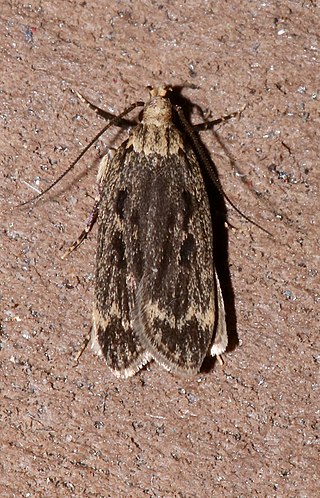
Monochroa is a genus of moths in the family Gelechiidae.

Monochroa lucidella is a moth of the family Gelechiidae. It is found in most of Europe, except Spain, Switzerland and most of the Balkan Peninsula. It is recorded from the Near East and Siberia (Transbaikalia).

Monochroa cytisella is a moth of the family Gelechiidae and found in most of Europe. The larva feed in the stems of bracken causing a slight gall.

Monochroa lutulentella, the black neb, is a moth of the family Gelechiidae. It is widely distributed in northern Europe and the central European mountains, east to the Ural Mountains. The habitat consists of fens, marshes and on river-banks.

Eudonia zophochlaena is a moth in the family Crambidae. It was described by Edward Meyrick in 1923. It is endemic to New Zealand. It has been hypothesised that this species is a North Island endemic. The adults of this species are on the wing from December until February. The larvae of this species are leaf miners of the leather-leaf fern Pyrrosia eleagnifolia.
Xystophora asthenodes is a moth of the family Gelechiidae. It was described by Edward Meyrick in 1923. It is found in north-western India.
Monochroa cleodora is a moth of the family Gelechiidae. It was described by Edward Meyrick in 1935. It is found in Japan and Korea.
Monochroa discriminata is a moth of the family Gelechiidae. It was described by Edward Meyrick in 1923. It is found in North America, where it has been recorded from southern Ontario.
Monochroa harrisonella is a moth of the family Gelechiidae. It was described by August Busck in 1904. It is found in North America, where it has been recorded from California, Washington, British Columbia and Florida.
Monochroa monactis is a moth of the family Gelechiidae. It was described by Edward Meyrick in 1923. It is found in North America, where it has been recorded from southern Ontario and North Carolina.
Monochroa pentameris is a moth of the family Gelechiidae. It was described by Edward Meyrick in 1931. It is found on Honshu in Japan and Guangxi in China.
Monochroa agatha is a moth of the family Gelechiidae. It was described by Edward Meyrick in 1918. It is found in Assam, India.
Monochroa ingravata is a moth of the family Gelechiidae. It was described by Edward Meyrick in 1918. It is found in the Bengal region of what was then British India.
Monochroa repudiata is a moth of the family Gelechiidae. It was described by Edward Meyrick in 1923. It is found in Assam, India.
Monochroa pessocrossa is a moth of the family Gelechiidae. It was described by Edward Meyrick in 1926. It is found in the Russian Far East.
Monochroa chromophanes is a moth of the family Gelechiidae. It was described by Edward Meyrick in 1938. It is found in Yunnan, China.
Thiotricha xanthodora is a moth of the family Gelechiidae. It was described by Edward Meyrick in 1923. It is found in Myanmar.

Martyringa xeraula, the Himalayan grain moth, is a moth in the family Lecithoceridae. It was described by Edward Meyrick in 1910. It is found in India (Assam), western China, Japan and North America, where it has been recorded from Louisiana, Texas and from Florida to South Carolina.
Metathrinca ceromorpha is a moth in the family Xyloryctidae. It was described by Edward Meyrick in 1923. It is found in Assam, India.

Chrysorthenches porphyritis is a species of moth of the family Plutellidae. It was first described by Edward Meyrick in 1885 and is endemic to New Zealand. This species can be found on both the North and South Islands in open native forest and scrub at altitudes from sea level up to 1370 m. The larvae feed on Podocarpus laetus, P. totara, P. nivalis, and Phyllocladus alpinus. The larvae create a shelter by loosely spinning together the leaves of its host plant and can be found feeding in groups. The pupa is formed inside a thin cocoon. Hudson was of the opinion that this species had two broods a year. Adult moths are on the wing all year round. The adults of this species, particularly the female, are variable in colouration and in forewing pattern.





